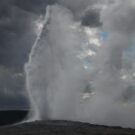Montana, The Treasure State

by Sandra Merville Hart
Montana’s nickname is The Treasure State for its rich mineral reserves, including the nation’s most valuable gemstone, sapphire.
The early history of Montana
The Louisiana Purchase of 1803 opened up Montana to explorers who drew maps of the land. Fur-trading companies traveled to Montana and built a trading post on the Bighorn River.
Montana became the Montana Territory in 1864, which meant citizens elected their legislature.
Discovery of gold
Prospectors traveled to Montana at the discovery of gold in 1862. Bannack City (originally Bannack) was the first boomtown established that same year.
Miners and prospectors came at every rumor of gold. Quickly built towns prospered until all the gold had been mined. Most miners left boomtowns in search of the next opportunity for riches.
The Battle of Little Bighorn
 General George Armstrong Custer led his cavalry troops in the Battle of Little Bighorn with the Sioux and Cheyenne on June 25, 1876. All U.S. soldiers died in what became known as “Custer’s Last Stand.”
General George Armstrong Custer led his cavalry troops in the Battle of Little Bighorn with the Sioux and Cheyenne on June 25, 1876. All U.S. soldiers died in what became known as “Custer’s Last Stand.”
Learn about the plains Indians and U.S. military at Little Bighorn Battlefield National Monument.
Yellowstone National Park
Yellowstone National Park became the country’s first national park in 1872. The park has areas in southern Montana and northern Wyoming.
Cattle drives to Montana from Texas ended late in the 1800s. Cattle ranchers didn’t get along with sheepherders. In 1886, about 60% of cattle died from extreme weather and overgrazing.
Montana becomes a state
Montana became a state on November 8, 1889. The capital is Helena.
National Bison Range
To protect bison from extinction, Montana created the National Bison in 1908. Around 500 bison live with elk, bears, antelope, and deer on the refuge.
Temperatures climbed from -54 degrees Fahrenheit to 49 – a 103 degree change in 24 hours – in Loma. This happened in January of 1972, and is the country’s record for “greatest temperature change in a 24-hour period.”
Grizzly bears are the state animal. They live in Glacier National Park.
Both travel time to a market and population density are considered in the determination for frontier counties; 50 of 56 counties met the criteria in 2000.
The state flower is bitterroot.
Sources
Gutman, Bill. The Look-It-Up Book of the 50 States, Random House, 2002.
“Montana,” History.com, 2016/07/15 http://www.history.com/topics/us-states/montana.
“Montana,” State Symbols USA, 2016/07/15 http://www.statesymbolsusa.org/states/united-states/montana.
“Montana,” 50 States.com, 2016/07/15 http://www.50states.com/facts/montana.htm.






